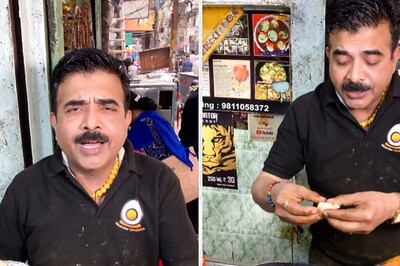
views
How to Wash Out Mustard Stains
Remove excess mustard and blot the stain. For fresh stains, gently scrape a dull knife or spoon across the affected area to remove as much mustard as possible, being careful not to rip the garment’s fibers. Then, dip a cloth or paper towel in water and blot the area to dilute the mustard. Note: This process is only for cleaning clothing and fabrics that can be washed in a washing machine. For clothes that are dry-clean only or fabrics that otherwise cannot be washed, go to the next section. If the stain isn’t fresh, first soak the fabric in cool water mixed with color-safe bleach for up to an hour, repeating as necessary to soften the stain. Scraping the excess mustard off is important because it reduces the risk of the mustard getting on other parts of the clothing and creating new stains. Do not try to remove the mustard with a paper towel, as this will only rub the condiment deeper into the fibers and make it harder to remove.
Rinse the back of the stain with cold water. Flip the fabric over or inside out so the back of the stain is facing out. Run it under plain, cold water to further dilute the stain and force as much of the mustard back out of the fabric as possible. Do not use warm water, as this could set the stain and make it more difficult to remove.
Spot treat the stain with laundry detergent. Flip the garment back around so the front of the stain is facing out. Rub a heavy-duty liquid laundry detergent onto the affected area and let the garment sit for up to 10 minutes. Rinse thoroughly with cold water, and repeat as necessary until there is no discoloration. If laundry detergent isn’t available, dish soap will also work. Other ways you can spot treat the stain include blotting on a bit of rubbing alcohol or non-sudsing ammonia with a cloth, applying a solvent-based laundry stain remover per the product’s instructions, or mixing oxygen bleach in tepid water and submerging the garment overnight.
Wash the garment in the washing machine. Wash the garment as you normally would with liquid laundry detergent. For an extra boost, apply a laundry stain remover. Before drying the item, make sure all the mustard has been removed. If the stain is still visible, repeat the steps above until you’re satisfied. Then, dry the garment like usual.
How to Dry Clean Mustard Stains
Scrape off excess mustard and apply a dry-cleaning solvent. Use a dull knife or spoon to remove as much mustard as possible, being careful not to rip the fibers of the garment. Then, follow the product’s instructions to apply a commercial dry-cleaning solvent stain remover to loosen the stain. This process works well for materials that cannot be washed in a washing machine, like rayon, silk, wool, and burlap. This method is meant for fresh stains only. If the mustard stain has already dried and set in, take the garment to a dry cleaner. Note that you cannot use a dry-cleaning solvent on leather, suede, or velvet. Instead, find a professional cleaner who offers services for these fabrics.
Scrub and blot the stain with a soft-bristle brush. A toothbrush works well. Gently brush and scrub the stained area to work the stain out as much as possible. Then, blot the area with an absorbent cloth to remove excess moisture.
Reapply the dry-cleaning solvent. Following the solvent’s instructions, apply it again to flush the stain, then check if any traces of mustard remain. If the stain is gone, let the garment dry. If not, scrub and blot the garment again, or move on to the following step.
Apply white vinegar to stubborn stains (optional). If the stain remains after applying the dry-cleaning solvent, dampen a sponge or pad and scrub the affected area, making light, outward strokes from the center of the stain. Then, add a few drops of distilled white vinegar to the wet sponge and gently scrub the stain out. Rinse the garment with clean water to see if the stain is gone. If the garment is white and the stain remains, continue to the next step. If it’s colored and still stained, this is the best you can do at home. Take it to a dry cleaner for additional help.
Apply hydrogen peroxide and ammonia if all else fails. If your white garment is still stained after applying the vinegar, moisten the affected area with 3% hydrogen peroxide and a drop of ammonia. Let it sit for a maximum of 15 minutes, then rinse with cold water and let it dry. When combined, hydrogen peroxide and ammonia can produce strong fumes. Use with caution and work in a well-ventilated area. The stain should be gone after this step, but if it still remains, it may be best to take the garment to a dry cleaner for professional assistance.
How to Get Mustard Out of Carpet & Upholstery
Blot the stain with dish soap and water. If there are any solid pieces of mustard, first remove them with a dull knife or spoon, being careful not to rub the fabric. Then, mix 1 tbsp (14.7 ml) of dish soap in 2 cups (473 ml) of warm water in a bowl. Dip a clean cloth into the solution and blot the stain, working from the outside edge to the center to keep it from spreading. As the mustard transfers to the cloth, switch to a clean area of the cloth and keep blotting. When the stain is gone, use a dry cloth or paper towel to soak up excess moisture. Repeat this step as needed until you can no longer see the stain. This method works for carpet and furniture and car upholstery. Before cleaning any furniture, however, always follow the manufacturer’s care label. This label is often found under sofa cushions or fabric skirts and features letter codes that indicate how to clean the piece. If the upholstery fabric is silk or vintage, lift away any solids, then contact a professional upholstery cleaner before proceeding.
Sponge the area with clean water. Dip another clean cloth in plain water and rub the area to rinse it. Make sure to remove any and all suds, as soapy residue will attract more dirt to the carpet or upholstery. If the area is very soapy, replace the water as needed until all the soap has been removed.
Dry and vacuum the area. Use another clean, dry cloth to blot the area dry. If the stain is gone, let the carpet or upholstery air dry away from direct heat. Then, vacuum the area to collect any stray fibers. If the stain is still there, repeat the previous steps until it has been completely removed. If you already tried the above method with no luck, try mixing oxygen bleach with cool water, following the package’s directions. Work the solution into the stain with a soft-bristle brush, but do not saturate the area. Let it sit for at least an hour, then blot the area with a dampened cloth to rinse. Let the carpet air dry, then vacuum.
How to Remove Other Condiment Stains from Clothes
Ketchup Rinse the stained area with water to remove as much ketchup as possible, then pretreat the garment with laundry detergent. Let it sit for a few minutes, then rinse and gently scrub the area with a soft-bristle brush. If the stain remains, dampen it with white vinegar and rinse again. Repeat these steps as necessary until the stain has been removed, then toss in the washing machine. If the garment is dry clean only, take it to the dry cleaner instead. This also applies to garments stained with mayo or BBQ sauce.
Mayo Apply dish soap to the stain and scrub it with a soft-bristle brush. Let it sit for up to 10 minutes, then rinse with clean water. Repeat as needed until the stain is completely gone. Or, simply pretreat the garment with a prewash stain remover, then wash with the hottest water that’s safe for the fabric.
BBQ sauce Scoop up any excess sauce, then run cold water through the back of the stain for several minutes. Rub liquid laundry detergent or dish soap onto the stain, working it in with your fingers. Let it sit for up to 10 minutes before rinsing with lukewarm water. Apply a bleaching agent (like white vinegar, lemon juice, or hydrogen peroxide) or a stain remover if needed, then run the item through the washing machine with the hottest water that is safe for the fabric. Check that the stain is completely gone before drying.
Removing Mustard Stains FAQs
Why does mustard stain? Mustard contains turmeric, a spice that gives the condiment its bright yellow color, and in turn, causes it to stain fabrics. Mustard seeds also contain tannins, a type of dye, which can also contribute to the problem. This condiment sets quickly, as well, which makes the stains even more difficult to remove.
Are mustard stains permanent? If the stain isn’t taken care of quickly, it can become permanent. Try the methods listed above, and if nothing works, take the item to a dry cleaner and explain everything you’ve tried so far. A professional may be able to reduce discoloration further, even if they can’t remove it altogether.
Will Dawn dish soap remove mustard stains? Yes, Dawn dish soap (and similar dish soaps) can often remove mustard stains. Mix 1/2 tsp of dish soap with 1/2 cup of cool water, then add a couple drops of white vinegar. Soak the stain for 20 minutes, then rinse with hot water and wash the item normally.




















Comments
0 comment